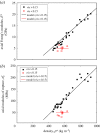The structure and mechanics of Moso bamboo material
- PMID: 25056211
- PMCID: PMC4233722
- DOI: 10.1098/rsif.2014.0321
The structure and mechanics of Moso bamboo material
Abstract
Although bamboo has been used structurally for millennia, there is currently increasing interest in the development of renewable and sustainable structural bamboo products (SBPs). These SBPs are analogous to wood products such as plywood, oriented strand board and glue-laminated wood. In this study, the properties of natural Moso bamboo (Phyllostachys pubescens) are investigated to further enable the processing and design of SBPs. The radial and longitudinal density gradients in bamboo give rise to variations in the mechanical properties. Here, we measure the flexural properties of Moso bamboo in the axial direction, along with the compressive strengths in the axial and transverse directions. Based on the microstructural variations (observed with scanning electron microscopy) and extrapolated solid cell wall properties of bamboo, we develop models, which describe the experimental results well. Compared to common North American construction woods loaded along the axial direction, Moso bamboo is approximately as stiff and substantially stronger, in both flexure and compression but denser. This work contributes to critical knowledge surrounding the microstructure and mechanical properties of bamboo, which are vital to the engineering and design of sustainable SBPs.
Keywords: bamboo; cellular solids; mechanical modelling; mechanical properties; microstructure.
© 2014 The Author(s) Published by the Royal Society. All rights reserved.
Figures














References
-
- Jiang Z. 2007. Bamboo and rattan in the world. Beijing, China: China Forestry Publishing House.
-
- Harries KA, Sharma B, Richard M. 2012. Structural use of full culm bamboo: the path to standardization. Int. J. Archit. Eng. Constr. 1, 66–75. (10.7492/IJAEC.2012.008.) - DOI
-
- Food and Agriculture Organization of the United Nations. 2010. Global Forest Resource Assessment 2010. Rome, Italy: Food and Agriculture Organization of the United Nations.
-
- Fu J. 2000. Moso bamboo in China. Am. Bamboo Soc. Mag. 21, 12–17.
-
- Ding X, Cai H, Chen Y, Zhang J. 2007. Systematic analysis on the quick development of bamboo industry in Zhejiang province: a case study for successful development approach of China's booming bamboo industry. Chin. For. Sci. Technol. 6, 74–82.
Publication types
MeSH terms
LinkOut - more resources
Full Text Sources
Other Literature Sources

